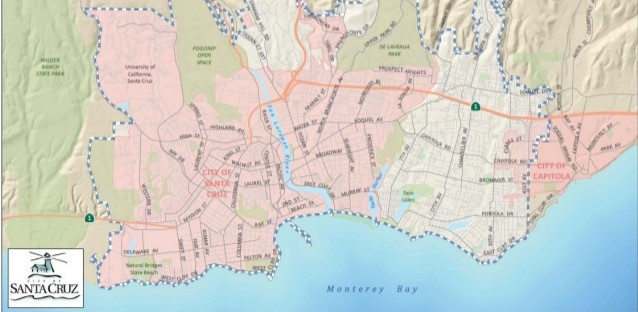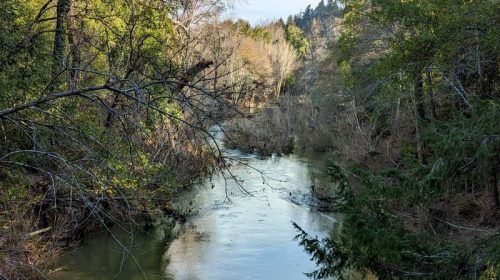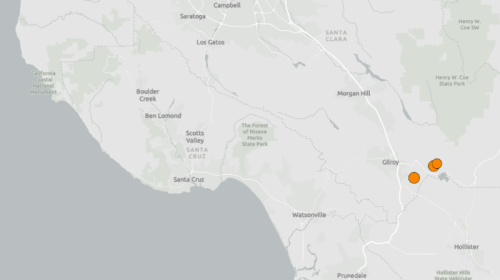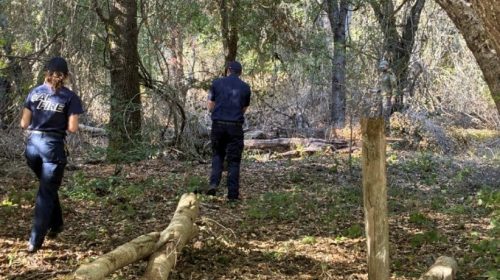City of Santa Cruz Water Department Petitions to Modify its Use of San Lorenzo River Water
Summary and Commentary
Prepared by Friends of San Lorenzo Valley Water
April 2, 2021
Introduction
The Santa Cruz City Water Department (SCWD) has submitted five separate petitions to the California State Water Resources Control Board (State Water Board) seeking changes to its permits and water rights associated with the San Lorenzo River.[1] The State Water Board oversees water rights throughout the state in a complex legal system that dates back more than a century.
SCWD has exclusive rights to the San Lorenzo River’s water. However, its rights are strictly regulated by the State Water Board. Restrictions include the total amount of water diverted annually; the rates and locations of diversions; how much water must be allowed to bypass diversion points (varying by time of year and drought conditions); and where and for what purposes the water can be used. These constraints have been in place for decades.
San Lorenzo Valley Water District (SLVWD) has a complementary set of water rights for various streams that flow into the river (e.g., Fall Creek, Bull Creek, and Bennett Springs in Felton, Clear Creek in Brookdale, and several creeks that flow into Boulder Creek).
SCWD states that it has been working on the proposed modifications for several years as part of a process to increase water availability in the region while protecting the San Lorenzo River watershed and fisheries. The modifications are needed as part of a long-term response to the effects of climate change and the likelihood of extended droughts.
What SCWD is Requesting[2]
SCWD is currently allowed to divert up to 3,000 acre-feet of water per year from the San Lorenzo River at the Felton Diversion Facility, all of which must be stored at Loch Lomond Reservoir. Although the total amount of permitted diversion would not change, SCWD’s petitions would modify where and when diversion is allowed and where and how it can be used. The major proposed changes include:
- Allow diversion at the Tait Diversion Dam in Santa Cruz as well as at the Felton Facility, and permit underground storage in the Tait and Beltz wells located in Santa Cruz city.[3] The petitions also propose direct use of the water. These changes would facilitate SCWD’s goals of servicing a larger geographic region.
- Increase the types of permitted uses for the water that is diverted. Currently, SCWD is restricted to using the water primarily for domestic and municipal use. The proposal would allow increased use associated with industry, recreation, fire protection and protection of water quality.
- Expand where the water can be shipped. Currently, the water can only be used within SCWD’s service area. The petition proposes to expand the area greatly, including Soquel Creek Water District, SVWD, SLVWD, the Central Water District, and Santa Margarita Groundwater Basins.
- Increase required river bypass flows below the Felton Diversion Dam. SCWD’s current permit requires water flows from between 10 cubic feet per second (cfs) and 25 cfs immediately downstream from the Felton diversion for the months September through May. Its proposal would prohibit any diversion during the summer months of June, July and August, and would increase the required river bypass flows below the Felton Diversion Dam to as high as 40 cfs for the period December through May before any diversion would be allowed. The stated purpose of this proposed revision is to improve the fisheries.
- Prohibit delivery of San Lorenzo River water to any other water supplier during drought conditions. The rationale for this proposed new restriction, although not explicit, is probably to protect the fisheries.
The SLVWD Protest
SLVWD has submitted a letter to the State Water Board protesting the last two proposals in the Santa Cruz petitions.[4]
- Increased bypass flow requirements at the Felton dam. SLVWD is concerned that the SCWD petition proposing to increase the required bypass flows just below the Felton Diversion Dam would compromise its plan to change its water rights for Fall Creek. This is a complex issue. SLVWD’s permit restricts it from diverting water from Fall Creek when the San Lorenzo River water level falls below specific levels as measured below the Felton dam (10, 20, or 25 cfs depending on the month of the year). Except in wet years, SLVWD is commonly out of compliance during the drier fall months between September and November. The SCWD proposal would not directly affect the SLVWD’s permit. However, SLVWD is preparing to petition the State Water Board to allow conjunctive use between Felton and other parts of the SLVWD system. The proposal would allow water to be shipped from the northern part of the SLV system to Felton, alleviating the Fall Creek over-drafting during the fall months, and permitting Fall Creek water to be diverted in the winter months to rest the wells in other parts of the district.
SLVWD is concerned that should the State Water Board accept the SCWD proposal, the higher 40 cfs restriction would be imposed on SLVWD when it submits its own petition, greatly decreasing the amount of water SLVWD can draw from Fall Creek. SLVWD’s protest requests that the State Water Board either delay consideration of the SCWD petition until SLVWD can submit its own petition so that the two petitions can be considered at the same time, or extend the protest period so that SLVWD has time to gather and submit additional information. SLVWD is considering a number of options as it prepares its petition that can both protect the fisheries and maintain its current rights to Fall Creek. For example, it could propose changing the location where the flow restrictions are imposed and narrowing them to the months when the steelhead migrate and spawn. Fisheries experts agree that the current SLVWD permit restrictions are not logically linked to the fish migration patterns.
- Prohibit delivery of San Lorenzo River water to any other water supplier during drought conditions. SLVWD has a contractual right (negotiated with SCWD, not a state-approved water right) to 313 acre feet/year of the water in the Loch Lomond Reservoir, which SCWD operates. SLVWD is not currently exercising its contractual right to this water, but may decide to do so in the future. The SLVWD district would need to spend approximately $1 million to build a pipeline to its Felton water treatment plant, which would need to be upgraded. Its protest letter requests that SCWD’s petitions be modified so that they do not compromise SLVWD’s contractual right. As discussed below, SLVWD’s Loch Lomond contractual right is an important aspect of the negotiations at the Santa Margarita Groundwater Agency.[5]
Commentary
SLVWD’s protest is narrowly written, challenging just two of the requested revisions. There are likely two reasons for SLVWD’s approach. First, SCWD has not yet submitted an Environmental Impact Statement. The petitions will again be subject to review and possible protests by SLVWD and other interested parties addressing potential adverse environmental impacts. Second, the State Water Board’s process is complex and highly legalistic. Protests must be well documented, and grounds for granting them are relatively narrow.
SLVWD board members and ratepayers have raised several additional issues regarding the petitions that warrant further investigation.
Will SCWD be drawing more water from the river?
SCWD has stated that it does not intend to draw more water from the San Lorenzo River than what it now diverts. Nevertheless, the petitions do make it possible for the City to draw more water in the future. Although the allowable amount of water to be diverted will not increase, it is highly likely that SCWD does not currently draw as much water as is permitted, given the current water rights restrictions. Adding storage space and options, a major component of the petitions, as well as an expanded potential area of service, provides a way for the City to use more of its permitted allotment, which suggests that more water is likely to be diverted—especially as the City of Santa Cruz continues its population growth. Drawing more water from the river, particularly from the Tait Diversion Facility, would appear to be at the core of the petition, since a major motivation for the submission is to provide more water to the region as a means to address climate change.
If SCWD does divert more water in the future, will this harm SLVWD, the fisheries, or the watershed?
This is a core issue. SCWD claims that this would not be the case. Its water system is designed to avoid these harms, and SCWD has made protecting fisheries a high priority. If the water is drawn downstream nearer to the city limits, then it is using water that would otherwise flow out to the ocean, potentially causing less environmental harm than if drawn upstream. The upcoming EIR should provide a basis for assessing these claims.
Should the use of San Lorenzo River water be expanded to industrial and recreational uses?
The petitions do not provide any details regarding these proposed expanded uses.
Should San Lorenzo River water be diverted to geographic regions outside the river watershed?
Long term regional planning is at the core of the petitions. Water shortages are likely to become more frequent due to droughts associated with climate change, and to meet this challenge, water districts in the region will need to cooperate and conserve. SCWD’s position is: If San Lorenzo water can be diverted before it flows to the ocean without harming the watershed or fisheries, then it should be used cooperatively to meet water needs in the region. Acting now may be critical to protecting the region’s long term water needs, for example by protecting against salt water intrusion, which might permanently damage aquifers outside the San Lorenzo River watershed.
A counter argument involves the following. Yes, we need regional planning – for example, the Santa Margarita aquifer and other aquifers do not recognize particular water district boundaries, so cooperation is essential to keeping them healthy as we face lengthy droughts due to climate change. The Santa Margarita Groundwater Agency (SMGWA) was formed precisely for this purpose, and is in the planning stages for restoring and protecting its aquifers. Should the first priority for the use of San Lorenzo River water be to replenish the aquifers within the river’s watershed, which would also have beneficial effects on groundwater-dependent ecosystems and base flow into tributaries such as Bean Creek, before exporting is considered?
What is the relationship of the SCWD petitions and SMGWA planning?
SCWD, while not a member agency of SMGWA, has a seat on its 11-member Board (SLVWD has two) and has been very active in the planning process. The proposed revisions to its water rights are clearly relevant to the SMGWA negotiations. For example, as discussed above, SCWD is proposing new cfs requirements on the river before water can be drawn. If these were to be applied to Fall Creek diversions, they would halve the amount of excess winter surface flow available from SLVWD to use for in lieu recharge; this, in turn, would increase the need for more pumping from the aquifers during winter months. All scenarios being considered by SMGWA to reach groundwater sustainability involve in lieu recharge, which is by far the least expensive strategy, especially when compared to forced-water injection wells which can cost between $10 – $15 million per well.
Why is SCWD seeking changes to its water rights at this juncture instead of coordinating its petitions with SMGWA’s plans for protecting the aquifers?
SCWD appears to be taking unilateral action regarding its water rights in the midst of a collaborative regional planning process and at the same time purporting to be doing so in the name of regional planning.
Conclusion: Potential Next Steps
SLVWD and SCWD have had informal discussions regarding possible resolutions to SLVWD’s protest on the two issues discussed above. The State Water Board will make the final decision regarding how the protest will be resolved. SCWD will be filing an EIR in the near future, which will provide an opportunity for interested parties to assess the potential environmental impact of SCWD’s petitions. Investigatory work can be done now, for example to examine the potential impact of the proposed changes and the likely increased diversions on fisheries and water quality. Influencing the State Water Board’s review of the EIR will require carefully-researched and well-reasoned arguments regarding the potential harm to the river, the fisheries, and its watershed. The potential impact of any protest will be increased if a collaborative effort is organized, e.g., having SLVWD, SCWD, Mt. Herman Water District, local environmental groups, and other interested parties working together.
The SMGWA deliberations provide an additional forum for addressing concerns regarding the petitions’ impact on regional planning. The SMGWA Board should be encouraged to review SCWD’s petitions, investigate their potential impacts on the SMGWA plans for protecting the aquifers, and request that SCWD delay further consideration of the SCWD petitions until the SMGWA process is completed.
[1] Each petition deals with a separate aspect of SCWD’s operations on the river. They will be summarized here in the aggregate, although the specific proposals may vary slightly based on operational location.
[2] The Notice of Petitions (a summary of the petitions issued by the State Water Board) can be accessed at https://www.slvwd.com/sites/g/files/vyhlif1176/f/agendas/bod_special_meeting_agenda.3.11.21with_back_up.pdf, pp. 6-22.
[3] A map of the proposed diversion points and well locations can be accessed at https://www.slvwd.com/sites/g/files/vyhlif1176/f/agendas/bod_special_meeting_agenda.3.11.21with_back_up.pdf, p. 22.
[4] The protest letter can be accessed at https://www.slvwd.com/sites/g/files/vyhlif1176/f/agendas/bod_special_meeting_agenda.3.11.21with_back_up.pdf, pp. 24-28.
[5] A map and description of the SMGW basin can be found at: https://smgwa.org/background/santa-margarita-basin/. Note that the southern half of Loch Lomond Reservoir is part of the basin.
https://www.friendsofsanlorenzovalleywater.org/water-rights
Image from City of Santa Cruz Water Department
The San Lorenzo Valley Post is your essential guide to life in the Santa Cruz Mountains. We're dedicated to delivering the latest news, events, and stories that matter to our community. From local government to schools, from environmental issues to the arts, we're committed to providing comprehensive and unbiased coverage. We believe in the power of community journalism and strive to be a platform for diverse voices.





